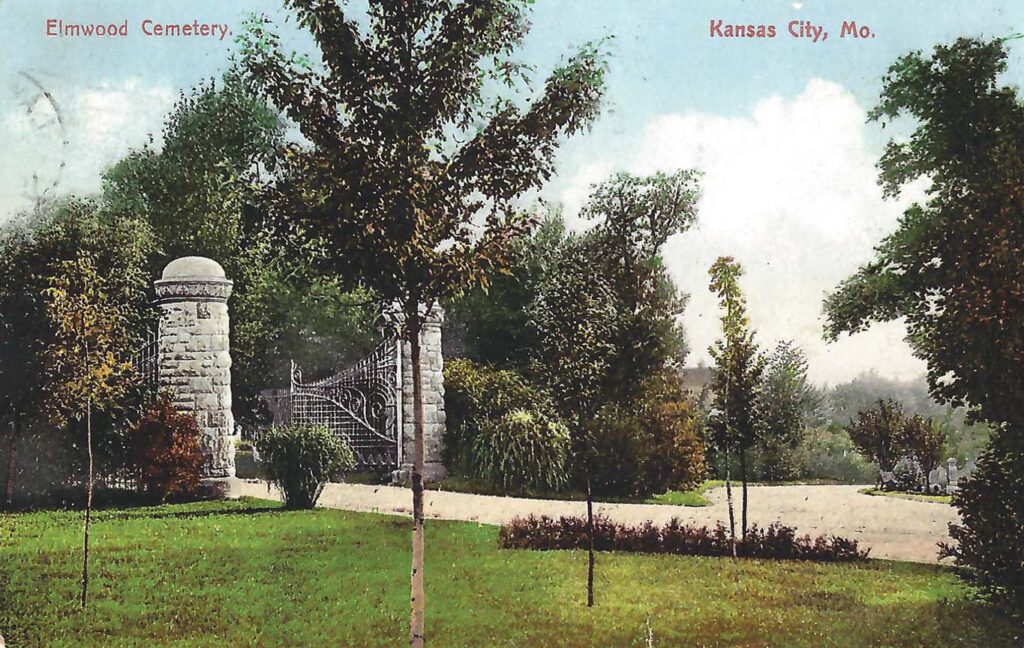
Michael Bushnell
Publisher
This week’s Historic Postcard column delves into how Elmwood Cemetery, integrated on all levels, is a reflection of Kansas City’s population racially, socio-economically and professionally. Paupers lay at rest next to captains of industry, brothel owners lay next to clergymen, and infants lay next to centenarians. Elmwood Cemetery is literally a cross section of Kansas City’s rich, diverse population.
Kansas City’s first Mayor, William S. Gregory is interred at Elmwood. Gregory farmed a plot of ground on Locust Street that was, 10 months into his one-year term, found to be outside the city limits. Gregory was removed and replaced by Dr. Johnston Lykins who was president of the City Council. At the time of his replacement in 1853, the City budget was a whopping $7.22 and the City Charter, a 16-page document, mandated only four meetings of the council over a 12-month period. Gregory is remembered today by Gregory Boulevard, one of the city’s most prominent east-west boulevards, named for him.
Elmwood’s first burial and, interestingly, one of its last, in 2019, were for infants. Sally Ayres, Elmwood’s first official burial after its formal organization, was only six months old when she died in 1872 of “summer complaint,” a malady often associated with food poisoning prior to the introduction of refrigeration. Fast forward to one of Elmwood’s most recent burials in 2019, 10-month old Emma Huling was re-interred in the family mausoleum at Elmwood after thieves broke into the crypt, stealing her casket. Huling was originally interred in 1865. The thieves, however, could not get her casket open and discarded it in a nearby shrub. Little Emma was given a full funeral ceremony, complete with bagpipes, on April 27, 2019, when she was re-interred in the family vault.
Musetta Moore Six, buried in Elmwood in 1955, was composer Cole Porter’s music teacher in Peru, Indiana. After moving to Kansas City, she secured a music instructor position in the Kansas City School District. When Porter, who by that time was all the rage on Broadway, would come through Kansas City, he would send a telegram to Moore noting the date and time of his stopover at the municipal airfield where Moore and her husband would spend time with Porter.
William F. Davis was Kansas City’s first African-American police officer during the early days when the uniform was nothing more than a metal badge clipped to the officer’s overcoat. Davis was appointed to the force in 1874, serving for 15 years prior to his death in 1891. In 2005, the Kansas City Police Historical Society dedicated a new headstone to Davis.
Officer Homer Darling, another Kansas City, Mo., police officer, bears the dubious distinction of being the first police officer in the United States to be killed in the line of duty on a motorcycle in 1911. Officer Darling, then a scant 26years old, was responding to a call and ran into a buggy near 17th and Prospect.
Leannah Loveall Kearns, one of the city’s most notorious madams, is buried at Elmwood. Better known as Annie Chambers in her professional circles, she operated one of the city’s busiest “bawdy houses” at roughly Third and Wyandotte for decades during the late 1800’s and early 1900’s. She converted to Christianity late in life, and upon her death she willed her house to what would become City Union Mission, one of the city’s foremost shelter organizations for the city’s homeless population.
Since its founding, Elmwood Cemetery continues to be a welcoming resting place for families of all faiths, creeds, races and socio-economic strata. Elmwood’s 150th anniversary celebration is slated for October 1. For a complete lineup of events, visit the Elmwood Cemetery website at
elmwoodcemeterykc.org.


















